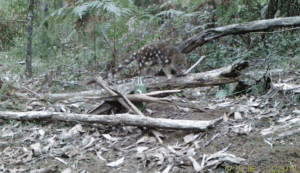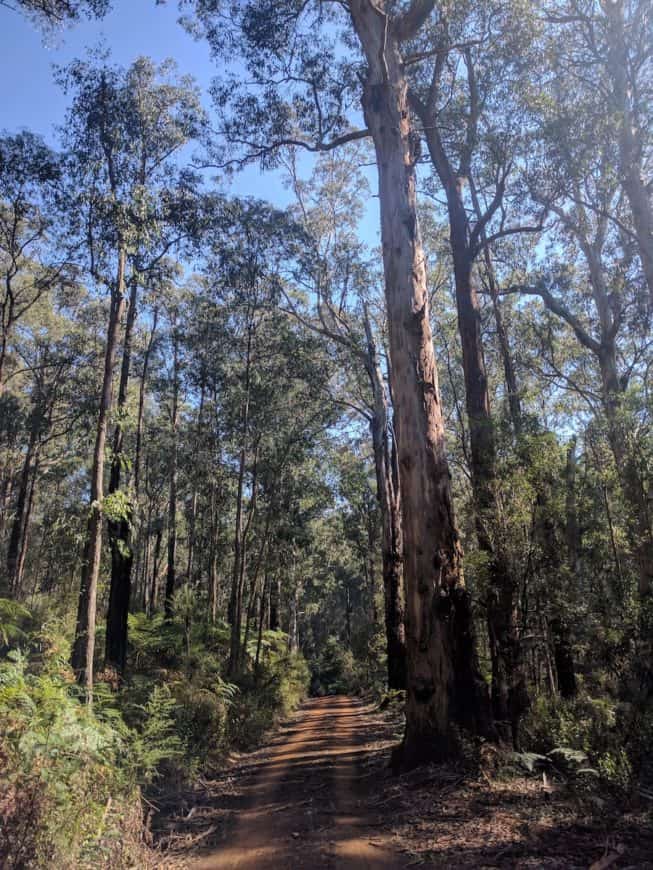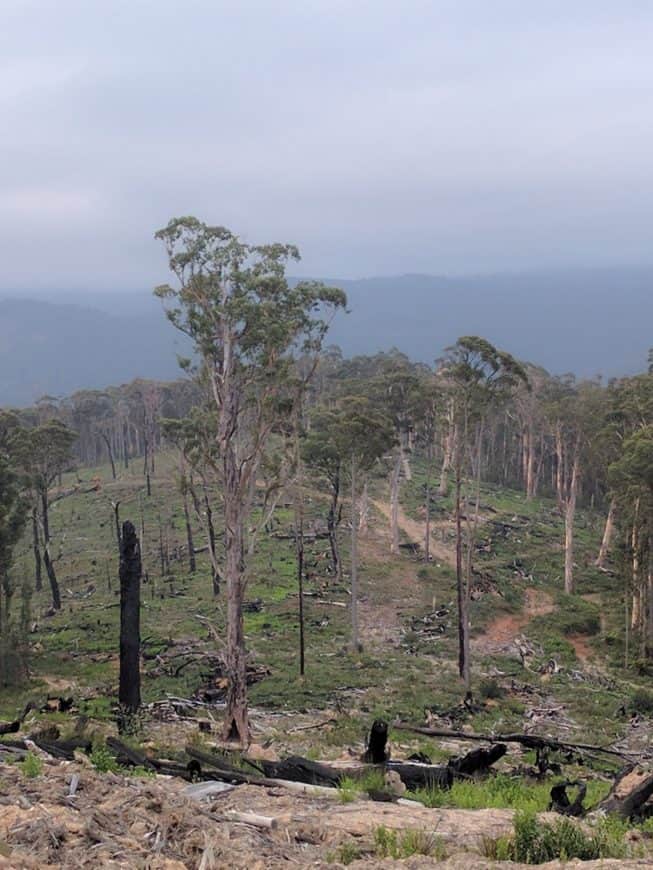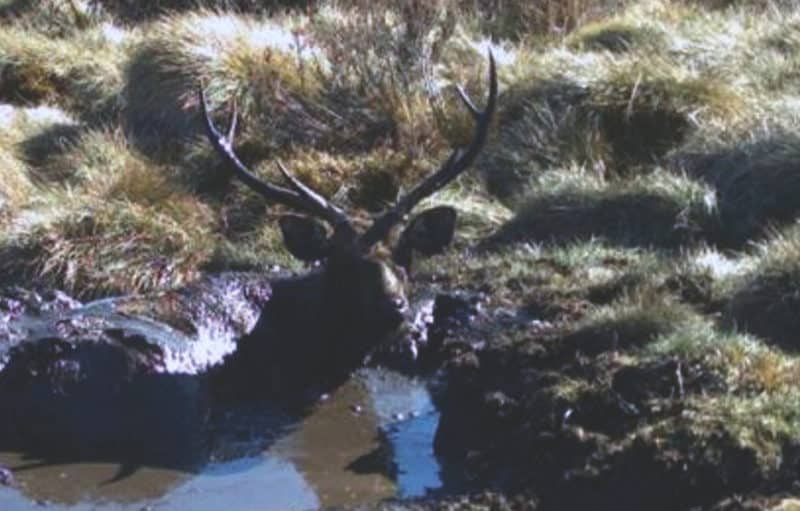PARK WATCH September 2018 |
An amazing story of individual perseverance in threatened species protection is shared by Bernie Mace and Milan Stupar.
Milan Stupar was guided by intuition and historical hints when he began searching for an elusive native animal in the Central Highlands.
His hunch resulted in the lawyer and keen bushwalker taking the initiative to set up remote sensing cameras in just the right place.
On 25 April this year, he finally saw what he had been looking for. His footage successfully recorded a large male spot-tail quoll, Dasyurus maculatus, in the forests of the Central Highlands, near Mount Baw Baw.
The species has not been reliably recorded in the Central Highlands for decades, and has not been systematically surveyed for evidence of a remnant population.
Milan is a Biological Science graduate from Monash University, but it was his strong personal interest in these mysterious marsupials that motivated his actions.
“My love for nature developed early in my life, when I used to spend a lot of time in my grandparents’ village, high up in the remote and pristine mountains of northwest Bosnia, where wolves still howl in the mountains and brown bears are numerous,” Milan says.
“This connection with nature continued when I came to Australia as a refugee at twelve years of age. I continued to immerse myself in nature, by heading out into our parks and state forests at most opportunities, exploring and photographing my experiences.
“I became fascinated with the quoll a few years ago, and the more I read the more I realised just how rare these animals are, particularly here in Victoria.
“I decided to purchase a remote sensing camera and try my luck in photographing this cryptic marsupial. “After trying a few different locations, over a period of six months, from Mount Samaria State Park, Strzelecki Ranges and Toorongo Plateau, I was able to finally photograph one near the southern slopes of Mount Baw Baw in Erica State Forest.”

There were only historical records of the spot-tail quoll in the area. The entire Victorian population of the species is critically low. Anyone who has tried to find them anywhere in the state knows just how hard it is to get a glimpse of the elusive creatures, even in known habitat areas, when their numbers are now so limited.
On hearing of this successful recording, Bernie Mace, a retired Materials Scientist with a long-held interest in carnivorous marsupials, was prompted to contact Milan. With personal experience sighting quolls in Victoria and Tasmania, Bernie lives in Toolangi and has been collecting evidence (mainly anecdotal observations) for years, particularly since the horrific experience of the Black Saturday bushfires in 2009.
This latest verification of the continued existence of this very rare animal in the Central Highlands forests has signalled the need for exhaustive efforts to study and conserve this important remnant population.
What is a quoll?
The spot-tail quoll is a marsupial carnivore, and in fact, the largest surviving example of this genre on the Australian mainland. This species is also known as the tiger quoll. The spot-tail quoll is distinctive because of its strongly spotted coat, and has this feature continuing along the tail. Other species of quoll, such as the eastern quoll Dasyurus viverrinus, do not have spots on the tail, so are instantly distinguishable from this largest member of the family.
The spot-tail quoll is the most arboreal of the Dasyurus family, with sharp claws, clasping toes and serrated pads on the feet to assist in tree climbing. It also has very powerful jaws, can prey successfully on animals heavier than itself, and has been described as very agile in pursuit of prey, such as possums, in the forest canopy. It has a well-deserved reputation for ferocity in its hunting behaviour. On the Australian mainland, the spot-tail quoll is the top-order marsupial predator, however in the most part there are insufficient individuals to effectively perform this vital role on a landscape scale.
It is mainly nocturnal in its habits, which helps to explain its ‘secretive’ reputation. It has huge home ranges, needing large areas of intact habitat.
Conservation status
The spot-tail quoll is listed as endangered under the national Environment Protection and Biodiversity Conservation Act 1999.
However, the native forest timber industry is exempt from these national environmental laws due to Regional Forest Agreements (RFAs).
These animals are incredibly cryptic in their behavior and, consequently, can be easily overlooked in areas subject to logging or other threatening human activities. The Erica State Forest and Toolangi State Forest are cases in point, where remnant populations have been hanging on largely unrecognised, acutely in danger of being lost. In such areas, appropriate action could save them from local extinction.
Under state law of the Fauna and Flora Guarantee Act 1998 and forestry regulation in the Central Highlands Regional Forest Agreement (RFA) region, the species requires a 500-hectare Special Protection Zone (SPZ) where logging operations will be prohibited. This requirement has been acknowledged by VicForests and the Minister of the Environment Lily D’Ambrosio in the media. However, the state government has decided to use a weaker Special Management Zone (SMZ) which covers a larger area of 1,000 hectares, but allows for half of it to be logged in the future.
An intended logging operation, less than two kilometres from the spot where the quoll was found, was suspended, but is still on the logging schedule. Months later we are still waiting for this permanent protection to be put in place.
We look forward to seeing details of action to implement these protection measures around this most recent sighting location.
As well as the major and ongoing threat of habitat loss, regular programs of poison baiting in wide-spread areas of Victoria are potentially devastating for this animal. It is admitted in official government documents that females and juvenile quolls can be killed by 1080 doses designed for fox and wild dogs.
A different approach is needed, and surely human ingenuity can find a way to remove fox from the environment without wiping out the dwindling population of our magnificent spot-tail quoll.
Some lessons to be learned from this timely discovery are:
- There is much to learn about the complexities and components of ecosystems, and this spot-tail quoll, an adult male, represents a species whose presence in this region we could only speculate about prior to obtaining this photographic evidence.
- It was photographed in an area of mixed age and mixed species native forest, containing many large mature trees. This helps to illustrate the value of maturing native forests, with remnant stands of old growth, for the biodiversity they can support. We know from past studies of the spot-tail quoll that it prefers to live in mature forest, containing tree hollows that represent den sites for daylight security, as well as supporting a rich complement of resident prey species that are necessary dietary options for a hungry quoll.
What action is needed to help the quoll to survive?
Their needs are simple: habitat, particularly old growth forests with plenty of hollow-bearing trees and good connectivity across the landscape; food supply from healthy populations of prey species; and an absence of threats such as poison baiting programs, predation or competition from feral predators, and human disturbance.
Local extinctions are stepping stones to diminishing gene pools, and ultimately, to total extinction.
Consequently, saving them requires the following responses as a minimal starting point:
- We must retain all old growth forest, in all areas where this precious habitat remains.
- We must minimise all processes that are destructive to native forests, particularly clear fell logging, and transition the timber industry into plantations.
- We must put an end to, or greatly refine, poison baiting as employed in feral predator control programs.
- We must increase public (and official) awareness of the existence and significance of these beautiful animals.
- We must prioritize the need for action to protect them, including stronger environmental laws at both state and federal level, and immediate introduction of a 500-hectare special protection zone around the recent sighting at Mount Baw Baw.
Much has been said about the extinction of the thylacine, and how stupid we were to lose such a significant and obviously threatened species, despite strong warnings from concerned scientists. The eastern quoll has already been lost from mainland Australia, from an extremely healthy population base at the turn of the 20th century. Let us learn from these tragic errors and take appropriate action to not only save the spot-tail quoll from extinction, but to ensure its return to a healthy population.
Australia’s deplorable record of mammal extinctions is well known, and our leaders must take responsible action to reverse the previous negative trends. A genuine respect for nature and for its effective stewardship must be prioritized at this time.
As the necessary scientific advice is now overwhelming and being more urgently communicated, there are no longer any excuses for inaction.
Milan and Bernie hope more action to protect the spot-tail quoll and its habitat is forthcoming.
“We hope that the Victorian community can band together and figure out a way to protect the species for future generations now that we have evidence of their ongoing existence in the Central Highlands.”


Take Action
Write or email the Victorian Environment Minister and ask for better protection for spot-tail quolls and the immediate introduction of a 500-hectare Special Protection Zone around the recent sighting.
The Hon. Lily D’Ambrosio MP
Level 16 8 Nicholson Street
East Melbourne
Victoria, 3002
lily.d’[email protected]
Did you like reading this article? Want to be kept up to date about nature issues in Victoria? Subscribe to our email updates.
You can also receive our print magazine Park Watch four times a year by becoming a member. Find out more here.
